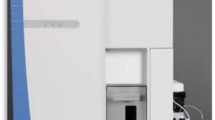Abstract
A simple and sensitive liquid chromatography–tandem mass spectrometry (LC–MS/MS) in the positive electrospray ionization mode was developed and validated in order to analyze cefaclor, a second generation cephalosporin antibiotic, in rat plasma. The plasma was pre-treated by a single step of protein precipitation with methanol, and then injected directly into the LC/MS/MS system for quantification. Drugs were separated on a Synergi 4μ Polar-RP 80 A column (150 × 2.0 mm) with a mixture of 0.1 % formic acid and methanol (65 : 35, v/v) as the mobile phase at 0.2 mL/min. Detection was performed with multiple reaction-monitoring modes at m/z 368.1 → 174.2 (for cefaclor) and m/z 396.0 → 227.1 (for cefdinir, the internal standard). The limit of quantification (LOQ) was determined to be 10 ng/mL with acceptable linearity ranging from 10 to 10,000 ng/mL. Validation parameters for cefaclor, including accuracy, precision, absolute matrix effect, and stability in rat plasma, were acceptable according to the assay validation guidelines of the FDA (U.S. Department of Health & Human Services, Food and Drug Administration, Guidance for Industry, Bioanalytical Method Validation, 2001). The developed analytical method was successfully applied to the pharmacokinetic studies of cefaclor in rats. These observations suggest, therefore, that the validated assay can be used in routine pharmacokinetic studies of cefaclor in rats.



Similar content being viewed by others
References
Chen X, Zhong D, Huang B, Cui J (2003) Determination of cefaclor in human plasma by a sensitive and specific liquid chromatographic–tandem mass spectrometric method. J Chromatogr B Analyt Technol Biomed Life Sci 784:17–24
Chen J, Jiang B, Lou H, Yu L, Ruan Z (2012) Bioequivalence studies of 2 oral cefaclor capsule formulations in chinnese healthy subjects. Arzneimittelforschung 62:134–137
FDA (2001) US Department of Health & Human Services, Food and Drug Administration, Guidance for Industry, Bioanalytical Method Validation
Gibaldi M, Perrier D (1982) Pharmacokinetics, 2nd revised and expanded. Informa HealthCare, New York, pp 409–416
Gupta S, Prasad BB (2000) Determination of cefaclor by selective sample enrichment/clean-up on silica gel bonded polyelectrolyte in ion-exchange column chromatography. J Pharm Biomed Anal 23:307–313
Jin HE, Lee KR, Kang IH, Chung SJ, Shim CK (2011) Determination of zabofloxacin in rat plasma by liquid chromatography with mass spectrometry and its application to pharmacokinetic study. J Pharm Biomed Anal 54:873–877
Jin HE, Kim IB, Kim CK, Maeng HJ (2013a) Determination of cefdinir levels in rat plasma and urine by high-performance liquid chromatography–tandem mass spectrometry: application to pharmacokinetics after oral and intravenous administration of cefdinir. Biomed Chromatogr. doi:10.1002/bmc.2938
Jin HE, Song B, Kim SB, Shim WS, Kim DD, Chong S, Chung SJ, Shim CK (2013b) Transport of gemifloxacin, a 4th generation quinolone antibiotic, in the Caco-2 and engineered MDCKII cells, and potential involvement of efflux transporters in the intestinal absorption of the drug. Xenobiotica 43:355–367
Kovach PM, Lantz RJ, Brier G (1991) High-performance liquid chromatographic determination of loracarbef, a potential metabolite, cefaclor and cephalexin in human plasma, serum and urine. J Chromatogr 567:129–139
Li JM, Li C, Jiang Y, Ren SM (2010) Pretreatment of plasma samples by a novel hollow fiber centrifugal ultrafiltrate device for the determination of cefaclor concentrations in human plasma. J Chromatogr A 1217:6824–6828
Oguma T, Yamada H, Sawaki M, Narita N (1991) Pharmacokinetic analysis of the effects of different foods on absorption of cefaclor. Antimicrob Agents Chemother 35:1729–1735
Onyeji CO, Nicolau DP, Nightingale CH, Quintiliani R (1994) Optimal times above MICs of ceftibuten and cefaclor in experimental intra-abdominal infections. Antimicrob Agents Chemother 38:1112–1117
Author information
Authors and Affiliations
Corresponding author
Rights and permissions
About this article
Cite this article
Jin, HE., Kim, Y.C. & Maeng, HJ. Liquid chromatography–tandem mass spectrometry for quantification of cefaclor in rat plasma and its application to pharmacokinetic studies. Journal of Pharmaceutical Investigation 44, 133–139 (2014). https://doi.org/10.1007/s40005-013-0109-9
Received:
Accepted:
Published:
Issue Date:
DOI: https://doi.org/10.1007/s40005-013-0109-9




